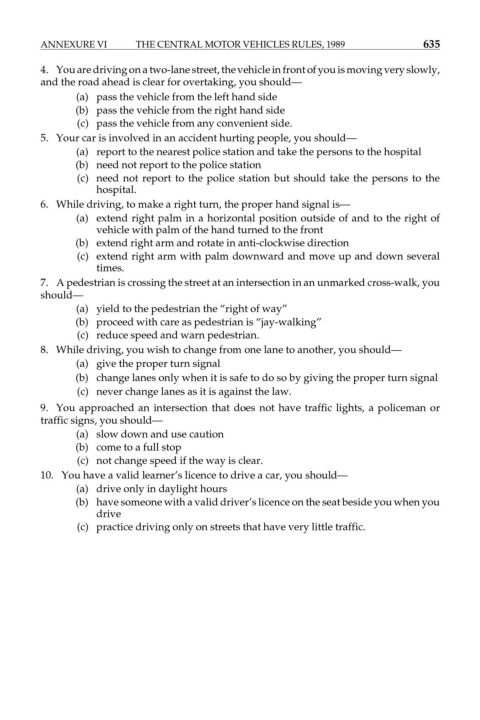Page 663 - The Central Motor Vehicles Rules, 1989
P. 663
ANNEXURE VI THE CENTRAL MOTOR VEHICLES RULES, 1989 635
4. You are driving on a two-lane street, the vehicle in front of you is moving very slowly,
and the road ahead is clear for overtaking, you should—
(a) pass the vehicle from the left hand side
(b) pass the vehicle from the right hand side
(c) pass the vehicle from any convenient side.
5. Your car is involved in an accident hurting people, you should—
(a) report to the nearest police station and take the persons to the hospital
(b) need not report to the police station
(c) need not report to the police station but should take the persons to the
hospital.
6. While driving, to make a right turn, the proper hand signal is—
(a) extend right palm in a horizontal position outside of and to the right of
vehicle with palm of the hand turned to the front
(b) extend right arm and rotate in anti-clockwise direction
(c) extend right arm with palm downward and move up and down several
times.
7. A pedestrian is crossing the street at an intersection in an unmarked cross-walk, you
should—
(a) yield to the pedestrian the “right of way”
(b) proceed with care as pedestrian is “jay-walking”
(c) reduce speed and warn pedestrian.
8. While driving, you wish to change from one lane to another, you should—
(a) give the proper turn signal
(b) change lanes only when it is safe to do so by giving the proper turn signal
(c) never change lanes as it is against the law.
9. You approached an intersection that does not have traffic lights, a policeman or
traffic signs, you should—
(a) slow down and use caution
(b) come to a full stop
(c) not change speed if the way is clear.
10. You have a valid learner’s licence to drive a car, you should—
(a) drive only in daylight hours
(b) have someone with a valid driver’s licence on the seat beside you when you
drive
(c) practice driving only on streets that have very little traffic.

